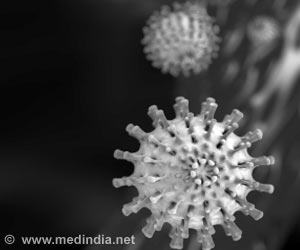Formation of a soccer ball-shaped nanoparticle, also known as a buckyball, is due to the breakdown of larger structures, a new study by researchers reveals.

Two theories compete regarding the molecular mechanisms that make fullerenes. The first and oldest is the "bottom-up" theory, which says these carbon cages are built atom-by-atom, like the construction of a Lego model. The second, more recent, theory takes a "top-down" approach, suggesting that fullerenes form when much larger structures break into constituent parts.
After several years of debate with little more than computational models in support of how the top-down theory might work, researchers led by Harry Dorn, a professor at the research institute, have discovered the missing link: asymmetrical fullerenes that are formed from larger structures appear to settle into stable fullerenes.
The discovery appeared online Sept. 15 in the journal Nature Chemistry.
"Understanding the molecular mechanics of how fullerenes and their many variations are formed is not just a curiosity," said Dorn, who has been researching metallofullerenes – fullerenes with a few atoms of metal held within – for more than two decades. "It would give us insights into new, better ways to prepare them. Fullerenes and metallofullerenes are already involved in hundreds of biomedical studies. The ability to create large numbers of a wide variety of metallofullerenes would be a giant building block that would take the field to new heights."
The medicinal promise of metallofullerenes stems from the atoms of metal caged within them. Because the metal atoms are trapped in a cage of carbon, they do not react with the outside world, making their side-effect risks low in both number and intensity.
Advertisement
"A better understanding of the formation of fullerenes and metallofullerenes may allow the development of new contrast agents for magnetic resonance imaging at commercial-level quantities," said Jianyuan Zhang, a graduate student in Dorn's laboratory and the first author of the paper. "These larger quantities will facilitate a next generation of contrast agents with multiple targets."
Advertisement
When Dorn and his colleagues determined the metallofullerene's exact structure using nuclear magnetic resonance imaging and single crystal X-ray analysis, they made a startling discovery —the asymmetrical molecule could theoretically collapse to form nearly every known fullerene and metallofullerene.
All the process would require would be a few minor perturbations — the breaking of only a few molecular bonds — and the cage would become highly symmetrical and stable.
This insight, Dorn said, supports the theory that fullerenes are formed from graphene — a single sheet of carbon just one atom thick — when key molecular bonds begin to break down. And although the study focuses on fullerenes with yttrium trapped inside, it also shows that the carbon distribution looks similar for empty cages, suggesting regular fullerenes form the same way.
"Not only are the findings presented in Dr. Dorn's paper extremely interesting, but the study represents a real milestone in the field," said Takeshi Akasaka, a professor of chemistry at the University of Tsukuba in Japan and an authority in the field of metallofullerene research, who was not involved in the study. "The study presents physical evidence for a process of metallofullerene creation that most scientists in the field initially scoffed at."
Dorn said scientists have questioned the bottom-up theory of fullerene formation ever since it was discovered that fullerenes were formed from asteroids colliding with Earth and fullerenes were found in interstellar space.
"With this study, we hope to be that much closer to understanding their formation and creating entirely new classes of fullerenes and metallofullerenes that could be useful in medicine as well as in other fields that haven't even occurred to us yet," Dorn said.
"Dr. Dorn's insight into the fundamental process whereby fullerenes are formed is a major contribution to the field," said Michael Friedlander, executive director of the Virginia Tech Carilion Research Institute. "Understanding the molecular steps in their formation is key to realizing fully the potential of this versatile and potentially potent family of chemicals in medicine. Dr. Dorn's contributions to understanding these molecules are paving the way for the formulation of targeted novel diagnostics, therapeutics, and the combination of both—theranostics. This approach will provide an important component for tomorrow's arsenal of precision medicine."
Dorn and Zhang's research collaborators include Faye Bowles, a graduate student researcher; Marilyn Olmstead, a professor of chemistry; and Alan Balch, a distinguished professor of chemistry; all from the University of California, Davis.
Source-Eurekalert









